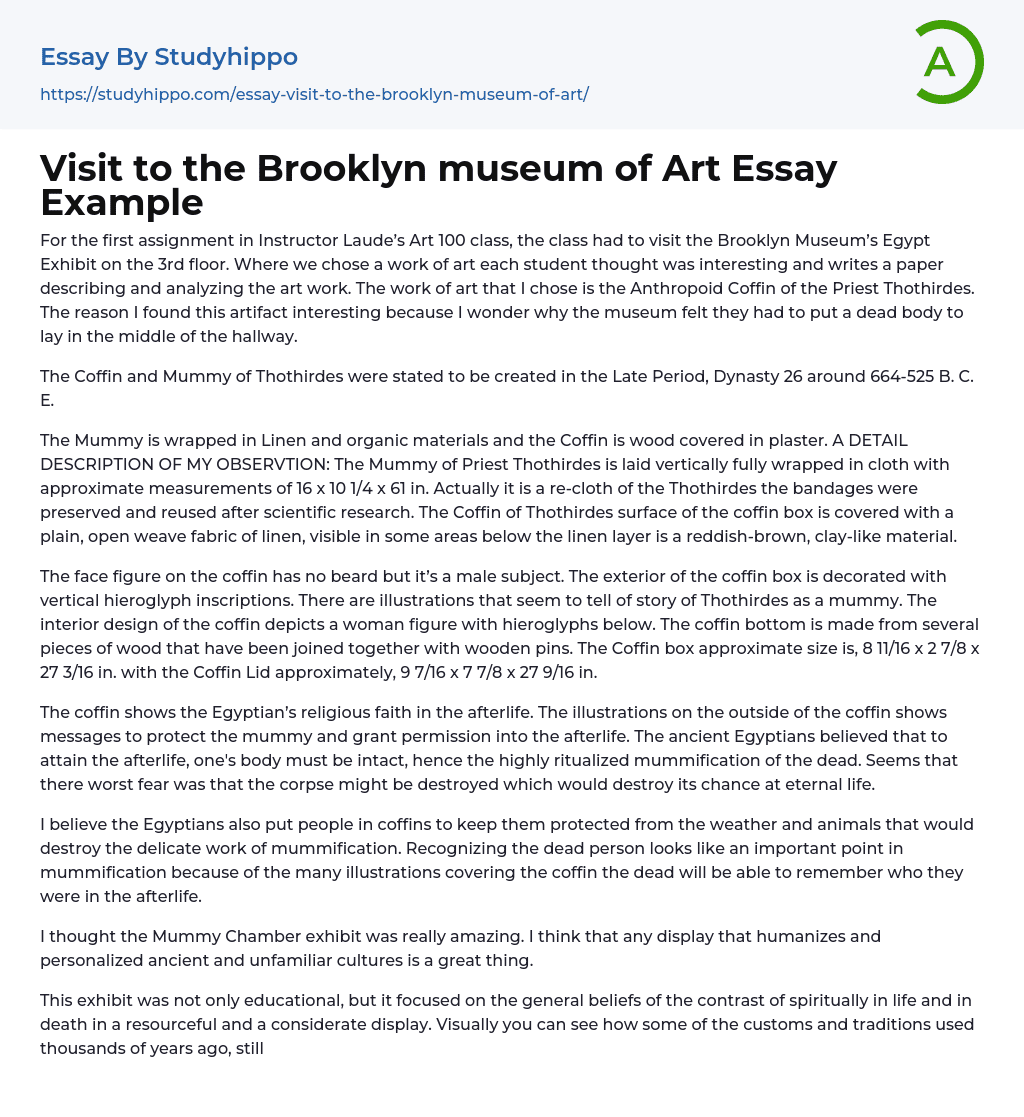For the first assignment in Instructor Laude’s Art 100 class, we had to visit the Brooklyn Museum’s Egypt Exhibit on the 3rd floor. Each student had to choose a work of art they found interesting and write a paper describing and analyzing it. I chose the Anthropoid Coffin of the Priest Thothirdes. What intrigued me about this artifact was why the museum decided to place a dead body in the middle of the hallway.
The Coffin and Mummy of Thothirdes were rumored to have been made during the Late Period, Dynasty 26, specifically around 664-525 B. C. E.
The Mummy is covered in Linen and organic materials, while the Coffin is made of wood covered in plaster. The Mummy, identified as Priest Thothirdes, is fully wrapped in cloth and measures approximately 16 x 10 1/4 x 61 inches. I
...nterestingly, the bandages have been preserved and reused after scientific research. As for the Coffin of Thothirdes, its surface is covered with a plain, open weave linen fabric. In some areas beneath the linen layer, a reddish-brown, clay-like material can be seen.
The coffin lacks a beard on its male figure and is decorated with vertical hieroglyphic inscriptions depicting Thothirdes' mummified story. Inside, there is a female statue accompanied by hieroglyphics underneath it. The lower part of the coffin consists of multiple wooden pieces connected by wooden pins. The approximate measurements for the coffin box are 8 11/16 x 2 7/8 x 27 3/16 inches, while the lid measures approximately 9 7/16 x 7 7/8 x 27 9/16 inches.
The coffin symbolizes the Egyptian faith in the afterlife and features illustrations wit
protective messages for the mummy's voyage to the afterlife. According to ancient Egyptians, preserving the body through a thorough mummification process was crucial for attaining eternal life. Their primary fear was that destroying the corpse would hinder their quest for everlasting life.
The Egyptians used coffins to protect bodies from weather and animals that could damage the mummification process. It is noticed that illustrating the coffin is important as it helps the deceased remember their identity in the afterlife.
I was impressed by the Mummy Chamber exhibit, as it effectively humanizes and personalizes ancient cultures.
The exhibit was educational and focused on the contrast of spirituality in life and death. It presented ancient customs and traditions that still hold significance in modern times. Initially, I believed that returning the mummies to their original location would be respectful, as removing them from burial sites seemed disrespectful. However, when considering society today, we only preserve what we want to share in the future. The Egyptians were highly intelligent people.
- Afterlife essays
- Atheism essays
- Bible essays
- Buddhism essays
- Christian Worldview essays
- Christianity essays
- Confession essays
- Cosmological Argument essays
- Deism essays
- Devil essays
- Existence of God essays
- Faith essays
- Freedom Of Religion essays
- God essays
- Hinduism essays
- Immortality essays
- Islam essays
- Jainism essays
- Jews essays
- Judaism essays
- Miracle essays
- Monk essays
- Monotheism essays
- New Testament essays
- Old Testament essays
- Pilgrimage essays
- Puritans essays
- Revelation essays
- Ritual essays
- Salvation essays
- Sin essays
- Sinners essays
- Soul essays
- Taoism essays
- Temple essays
- Theology essays
- Abolitionism essays
- Adam Smith essays
- American History essays
- American Revolution essays
- Ancient Egypt essays
- Articles Of Confederation essays
- Atlantic Slave Trade essays
- Aztec essays
- Benjamin Franklin essays
- Civil Rights Act of 1964 essays
- Civil Rights Movement essays
- Civil war essays
- Cleopatra essays
- French And Indian War essays




